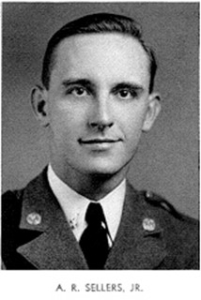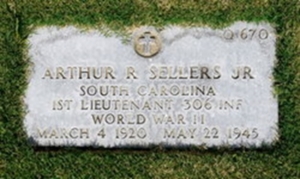Scroll of Honor – Arthur Raymond Sellers, Jr.
On Okinawa
Written by: Kelly Durham
Okinawa was the last great land campaign of the Pacific war—and by many accounts the most vicious. The Japanese considered Okinawa the last barrier between the Allies and the home islands. The Allies viewed the island, some 600 miles from Tokyo, as a vital staging area for the inevitable invasion of Japan. The 77th Infantry Division, which had been reorganized and trained at Fort Jackson, was among the American divisions fighting on Okinawa. First Lieutenant Arthur Raymond Sellers, Jr. of Florence was a member of A Company in the division’s 306th Infantry Regiment.
Sellers was a member of the last pre-war class, the Class of 1941. An industrial education major, he was a member of Iota Lambda Sigma, the national industrial education honor fraternity. He served as a member of the Wesley Foundation Council and the YMCA Council. He was also a member of the Pee Deeans, a social group formed by the boys from the counties along the Pee Dee River. Sellers completed ROTC training at Fort McClellan, Alabama during the summer of 1940 and served as cadet First Lieutenant and executive officer of Company D, First Battalion, Second Regiment in the Cadet Brigade.
Sellers married the former Patricia Noble of Central. Like most of his classmates, he reported for active duty shortly after graduation.
Assigned to the 77th Infantry Division at Fort Jackson, the 306th Infantry participated in the Louisiana Maneuvers of 1943. In March 1944, it shipped out from San Francisco, arriving in Hawaii on April 1. After amphibious training in Hawaii, the regiment saw its first combat during the liberation of Guam in July. It then helped liberate the Philippines in November. At some point, Sellers became ill and was evacuated to a hospital in New Guinea. He recuperated there for six weeks. Upon his release for duty, he was granted five days leave.
Sellers used his leave to track down and visit his brother, an aviation machinist mate in the Navy, who was then stationed in the Philippines. From there, in early May 1945, Sellers made his way back to the 306th Infantry on Okinawa.
The invasion of Okinawa had commenced with amphibious landings on April 1st. The Japanese, repeating the tactics employed so effectively on Iwo Jima, conceded the landings but retreated to well-fortified positions in the jagged coral cliffs of central Okinawa. With interlocking fields of fire, pre-sighted artillery targets, higher ground, and firing positions dug into the ridges and connected by tunnels and caves, the Japanese high command intended to hold out to the last man. In the process, the Japanese planned to inflict such severe losses that the Americans would be willing to negotiate peace terms rather than continue to demand unconditional surrender.
Shortly after his arrival at A Company, Sellers was ordered to take over new duties leading the company whose commanding officer, a friend of Sellers, had been wounded. By May 22, American Army and Marine divisions had penetrated to the inner ring of the Shuri line of Japanese defenses. Now the enemy line held against all attacks with little or no advances to report. On this day, under rainy skies that turned the battlefields into mud and restricted the use of Allied airpower and armored vehicles, First Lieutenant Sellers was fatally wounded while leading his company against the enemy.
Sellers was awarded the Bronze Star and the Purple Heart. He was survived by his mother, his father, his wife and their ten-month-old daughter whom he had never seen, a sister, and his brother in the Navy. He was buried at the Memorial Cemetery of the Pacific in Honolulu.
For more information on Arthur Raymond Sellers, Jr. see:
https://soh.alumni.clemson.edu/scroll/arthur-raymond-sellers-jr/
For additional information about Clemson University’s Scroll of Honor visit:
https://soh.alumni.clemson.edu/
